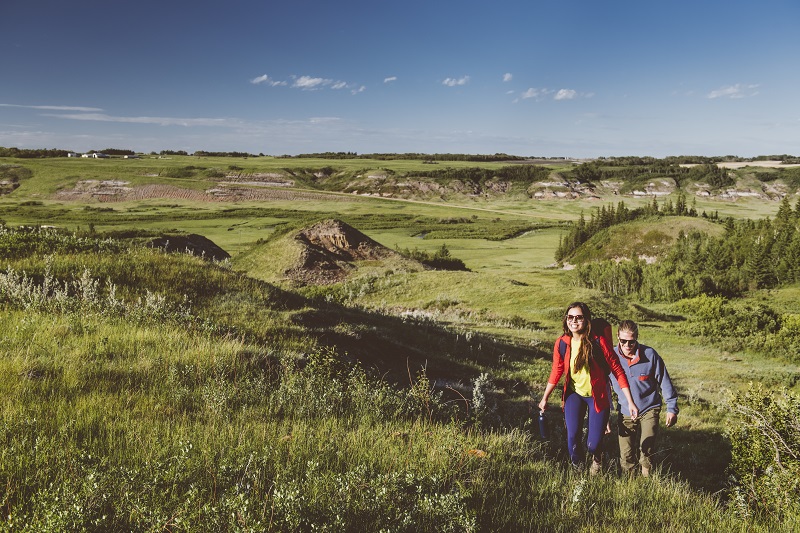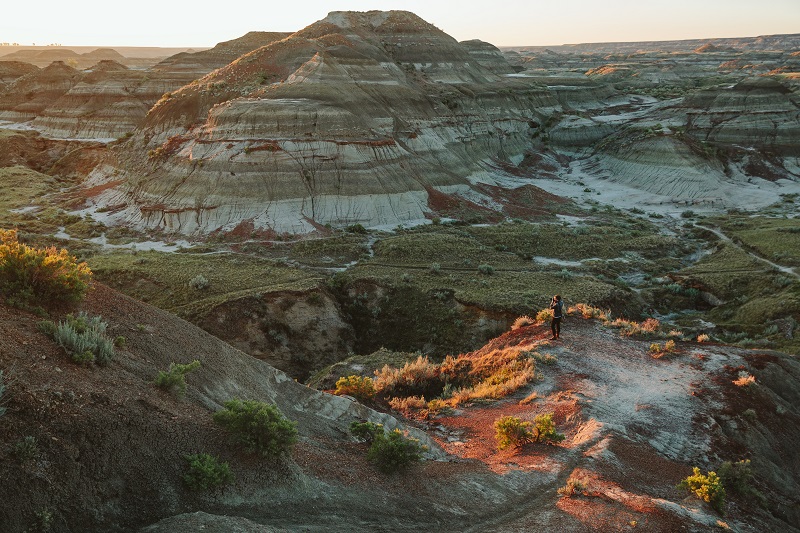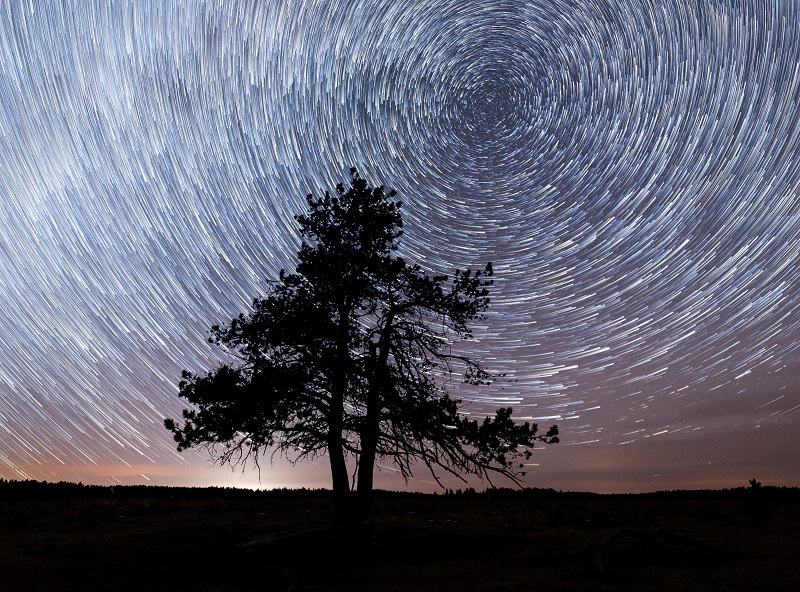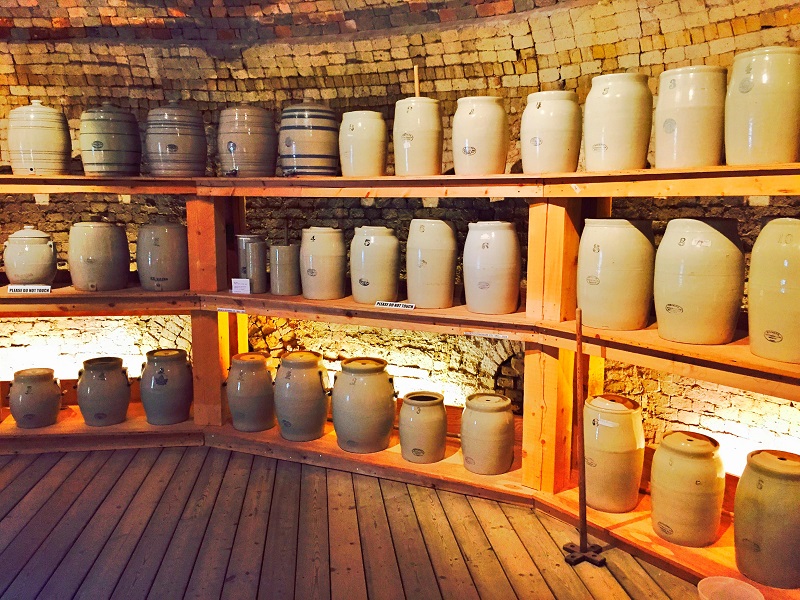While many know that Alberta’s Canadian Badlands are famous for dinosaur fossils and other prehistoric artifacts, but there’s much more to this diverse and scenic region.
From its impressive size to its broad range of attractions and destinations, it’s a perfect time to get to know the Canadian Badlands. Here are ten quirky facts about the Canadian Badlands that may surprise you:
1. At 90,000 square kilometres, the Canadian Badlands is bigger than Portugal.
Spanning east from Drumheller to the Saskatchewan border and south towards the United States border and north to Red Deer, this region encompasses many well-known towns and cities such as Medicine Hat, Fort Macleod, Stettler and Lethbridge.

Hiking in Donalda-Stettler Photo Courtesy AV Wakefield
2. The Canadian Badlands is the only region in Alberta home to the western small-footed bat.
This species of bat is classified as a Species of Special Concern by the province. Western small-footed bats typically roost in rock crevices, making the badlands and clay cutbacks an ideal habitat. The region is also home to the prairie rattlesnake, the short-horned lizard and various species of cacti.
3. The Canadian Badlands were formed more than 13,000 years ago as a result of glacial meltwater from the Laurentide ice sheet, but many of its roaring residents date back 75 million years to the Late Cretaceous period.
When dinosaurs roamed the Earth 75 million years ago, Alberta was a sub-tropical paradise with lush forests of sycamore and magnolia lining the coastal plains, making it the ideal climate for the preservation of dinosaur bones as fossils. It wasn’t until “recent” history (approximately 13,000 years ago) that the Canadian Badlands as we see them today were formed through a process of vigorous erosion of its sedimentary rocks.
4. You can stay in an actual caboose on a real train track.
Aspen Crossing Caboose Cabins in Mossleigh can take you back to a simpler time, with all the modern amenities. Get the authentic train car experience when you camp out in the Canadian Badlands.

Aspen Crossing Prairie Train Ride. Photo Courtesy Canadian Badlands Tourism
5. One of the most unusual fossils discovered in the Canadian Badlands isn’t actually a dinosaur.
A close relative of the dinosaur that walked the planet 225 million years ago, the leg bone of a pterosaur was discovered in Dinosaur Provincial Park. Even more impressive, the tooth of a small predatory dinosaur was embedded in its bone!
6. The hikes and trails in this region rival those found in Alberta’s Rocky Mountains.
Horseshoe Canyon is just one incredible destination in this region, offering scenic views and challenging terrain suitable for hiking and mountain biking. For beach lovers, it is hard to beat the trails contained in Park Lake Provincial Park, providing users with easy access to the water. No matter your hiking preference, you’ll find it in the Canadian Badlands.
7. The Canadian Badlands are home to 35 provincial parks and natural areas.
Not all clay and sediment, the Badlands are home to numerous recreational areas including Alexander Wilderness Park, Gooseberry Lake Provincial Park, and Rochon Sands Provincial Park.

Dinosaur Provincial Park Photo Courtesy Mike Seehagel
8. Early French explorers gave the Canadian Badlands region its current name.
Though the name may seem self-explanatory, this region’s steep-sloped, flat-top mountains and deep, winding gullies were noted as “bad lands to cross.”
9. The Canadian Badlands is home to some of the darkest skies in the world.
Take in the true beauty of the night sky at the Cypress Hills Observatory, conveniently located in the Cypress Hills Dark-Sky Preserve which is dedicated to keeping out artificial light that restricts the view. This dark-sky preserve is one of the darkest, most easily accessible, and one of the largest with 39,600 hectares protected – that’s the size of 97,850 football fields!

Cypress Hills Dark Sky Preserve Photo Courtesy Jeff Bartlett
10. Art, culture and history collide in this region, with retrofitted factories serving as museums.
Medalta in Medicine Hat is both an industrial museum and contemporary arts centre, utilizing past architecture and featuring artists who can help attendees craft their very own clay creations.

Medalta Clay Photo Courtesy Canadian Badlands Tourism
The Canadian Badlands is home to hundreds of cultural, historic and scenic destinations. Plus, if you really love dinosaurs, you’ll find the world’s largest in Drumheller, standing at 25 metres tall (that’s 4.5 times the size of an actual T-Rex). Scale the 106 steps to the top for a roaring good view.
Author: Canadian Badlands Tourism
Canadian Badlands Tourism (CBT) is a non-profit regional tourism agency for the Canadian Badlands, spanning 90,000 square km in Alberta. CBT is engaged in developing and promoting the region as Alberta’s next iconic-tourism destination. From urban centres to scenic drives, this region offers a diverse range of accommodations, attractions and events.



